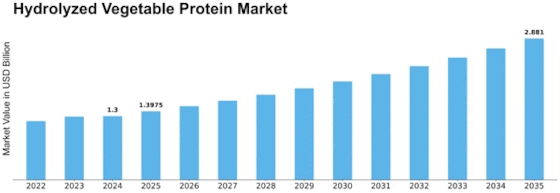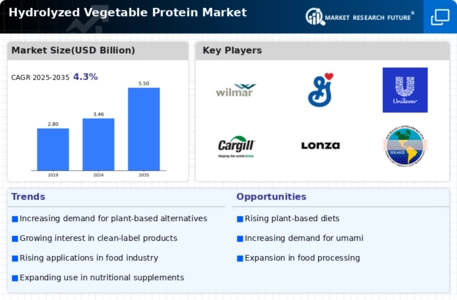Food Beverage
Animal Feed
Cosmetics
Pharmaceuticals
Soy
Corn
Wheat
Peas
Powder
Liquid
Granular
Flavor Enhancer
Nutritional Supplement
Emulsifier
Thickener
North America
Europe
South America
Asia Pacific
Middle East and Africa
North America Outlook (USD Billion, 2019-2035)
North America Hydrolyzed Vegetable Protein Market by Application Type
Food Beverage
Animal Feed
Cosmetics
Pharmaceuticals
North America Hydrolyzed Vegetable Protein Market by Source Type
Soy
Corn
Wheat
Peas
North America Hydrolyzed Vegetable Protein Market by Form Type
Powder
Liquid
Granular
North America Hydrolyzed Vegetable Protein Market by Functionality Type
Flavor Enhancer
Nutritional Supplement
Emulsifier
Thickener
North America Hydrolyzed Vegetable Protein Market by Regional Type
US
Canada
US Outlook (USD Billion, 2019-2035)
US Hydrolyzed Vegetable Protein Market by Application Type
Food Beverage
Animal Feed
Cosmetics
Pharmaceuticals
US Hydrolyzed Vegetable Protein Market by Source Type
Soy
Corn
Wheat
Peas
US Hydrolyzed Vegetable Protein Market by Form Type
Powder
Liquid
Granular
US Hydrolyzed Vegetable Protein Market by Functionality Type
Flavor Enhancer
Nutritional Supplement
Emulsifier
Thickener
CANADA Outlook (USD Billion, 2019-2035)
CANADA Hydrolyzed Vegetable Protein Market by Application Type
Food Beverage
Animal Feed
Cosmetics
Pharmaceuticals
CANADA Hydrolyzed Vegetable Protein Market by Source Type
Soy
Corn
Wheat
Peas
CANADA Hydrolyzed Vegetable Protein Market by Form Type
Powder
Liquid
Granular
CANADA Hydrolyzed Vegetable Protein Market by Functionality Type
Flavor Enhancer
Nutritional Supplement
Emulsifier
Thickener
Europe Outlook (USD Billion, 2019-2035)
Europe Hydrolyzed Vegetable Protein Market by Application Type
Food Beverage
Animal Feed
Cosmetics
Pharmaceuticals
Europe Hydrolyzed Vegetable Protein Market by Source Type
Soy
Corn
Wheat
Peas
Europe Hydrolyzed Vegetable Protein Market by Form Type
Powder
Liquid
Granular
Europe Hydrolyzed Vegetable Protein Market by Functionality Type
Flavor Enhancer
Nutritional Supplement
Emulsifier
Thickener
Europe Hydrolyzed Vegetable Protein Market by Regional Type
Germany
UK
France
Russia
Italy
Spain
Rest of Europe
GERMANY Outlook (USD Billion, 2019-2035)
GERMANY Hydrolyzed Vegetable Protein Market by Application Type
Food Beverage
Animal Feed
Cosmetics
Pharmaceuticals
GERMANY Hydrolyzed Vegetable Protein Market by Source Type
Soy
Corn
Wheat
Peas
GERMANY Hydrolyzed Vegetable Protein Market by Form Type
Powder
Liquid
Granular
GERMANY Hydrolyzed Vegetable Protein Market by Functionality Type
Flavor Enhancer
Nutritional Supplement
Emulsifier
Thickener
UK Outlook (USD Billion, 2019-2035)
UK Hydrolyzed Vegetable Protein Market by Application Type
Food Beverage
Animal Feed
Cosmetics
Pharmaceuticals
UK Hydrolyzed Vegetable Protein Market by Source Type
Soy
Corn
Wheat
Peas
UK Hydrolyzed Vegetable Protein Market by Form Type
Powder
Liquid
Granular
UK Hydrolyzed Vegetable Protein Market by Functionality Type
Flavor Enhancer
Nutritional Supplement
Emulsifier
Thickener
FRANCE Outlook (USD Billion, 2019-2035)
FRANCE Hydrolyzed Vegetable Protein Market by Application Type
Food Beverage
Animal Feed
Cosmetics
Pharmaceuticals
FRANCE Hydrolyzed Vegetable Protein Market by Source Type
Soy
Corn
Wheat
Peas
FRANCE Hydrolyzed Vegetable Protein Market by Form Type
Powder
Liquid
Granular
FRANCE Hydrolyzed Vegetable Protein Market by Functionality Type
Flavor Enhancer
Nutritional Supplement
Emulsifier
Thickener
RUSSIA Outlook (USD Billion, 2019-2035)
RUSSIA Hydrolyzed Vegetable Protein Market by Application Type
Food Beverage
Animal Feed
Cosmetics
Pharmaceuticals
RUSSIA Hydrolyzed Vegetable Protein Market by Source Type
Soy
Corn
Wheat
Peas
RUSSIA Hydrolyzed Vegetable Protein Market by Form Type
Powder
Liquid
Granular
RUSSIA Hydrolyzed Vegetable Protein Market by Functionality Type
Flavor Enhancer
Nutritional Supplement
Emulsifier
Thickener
ITALY Outlook (USD Billion, 2019-2035)
ITALY Hydrolyzed Vegetable Protein Market by Application Type
Food Beverage
Animal Feed
Cosmetics
Pharmaceuticals
ITALY Hydrolyzed Vegetable Protein Market by Source Type
Soy
Corn
Wheat
Peas
ITALY Hydrolyzed Vegetable Protein Market by Form Type
Powder
Liquid
Granular
ITALY Hydrolyzed Vegetable Protein Market by Functionality Type
Flavor Enhancer
Nutritional Supplement
Emulsifier
Thickener
SPAIN Outlook (USD Billion, 2019-2035)
SPAIN Hydrolyzed Vegetable Protein Market by Application Type
Food Beverage
Animal Feed
Cosmetics
Pharmaceuticals
SPAIN Hydrolyzed Vegetable Protein Market by Source Type
Soy
Corn
Wheat
Peas
SPAIN Hydrolyzed Vegetable Protein Market by Form Type
Powder
Liquid
Granular
SPAIN Hydrolyzed Vegetable Protein Market by Functionality Type
Flavor Enhancer
Nutritional Supplement
Emulsifier
Thickener
REST OF EUROPE Outlook (USD Billion, 2019-2035)
REST OF EUROPE Hydrolyzed Vegetable Protein Market by Application Type
Food Beverage
Animal Feed
Cosmetics
Pharmaceuticals
REST OF EUROPE Hydrolyzed Vegetable Protein Market by Source Type
Soy
Corn
Wheat
Peas
REST OF EUROPE Hydrolyzed Vegetable Protein Market by Form Type
Powder
Liquid
Granular
REST OF EUROPE Hydrolyzed Vegetable Protein Market by Functionality Type
Flavor Enhancer
Nutritional Supplement
Emulsifier
Thickener
APAC Outlook (USD Billion, 2019-2035)
APAC Hydrolyzed Vegetable Protein Market by Application Type
Food Beverage
Animal Feed
Cosmetics
Pharmaceuticals
APAC Hydrolyzed Vegetable Protein Market by Source Type
Soy
Corn
Wheat
Peas
APAC Hydrolyzed Vegetable Protein Market by Form Type
Powder
Liquid
Granular
APAC Hydrolyzed Vegetable Protein Market by Functionality Type
Flavor Enhancer
Nutritional Supplement
Emulsifier
Thickener
APAC Hydrolyzed Vegetable Protein Market by Regional Type
China
India
Japan
South Korea
Malaysia
Thailand
Indonesia
Rest of APAC
CHINA Outlook (USD Billion, 2019-2035)
CHINA Hydrolyzed Vegetable Protein Market by Application Type
Food Beverage
Animal Feed
Cosmetics
Pharmaceuticals
CHINA Hydrolyzed Vegetable Protein Market by Source Type
Soy
Corn
Wheat
Peas
CHINA Hydrolyzed Vegetable Protein Market by Form Type
Powder
Liquid
Granular
CHINA Hydrolyzed Vegetable Protein Market by Functionality Type
Flavor Enhancer
Nutritional Supplement
Emulsifier
Thickener
INDIA Outlook (USD Billion, 2019-2035)
INDIA Hydrolyzed Vegetable Protein Market by Application Type
Food Beverage
Animal Feed
Cosmetics
Pharmaceuticals
INDIA Hydrolyzed Vegetable Protein Market by Source Type
Soy
Corn
Wheat
Peas
INDIA Hydrolyzed Vegetable Protein Market by Form Type
Powder
Liquid
Granular
INDIA Hydrolyzed Vegetable Protein Market by Functionality Type
Flavor Enhancer
Nutritional Supplement
Emulsifier
Thickener
JAPAN Outlook (USD Billion, 2019-2035)
JAPAN Hydrolyzed Vegetable Protein Market by Application Type
Food Beverage
Animal Feed
Cosmetics
Pharmaceuticals
JAPAN Hydrolyzed Vegetable Protein Market by Source Type
Soy
Corn
Wheat
Peas
JAPAN Hydrolyzed Vegetable Protein Market by Form Type
Powder
Liquid
Granular
JAPAN Hydrolyzed Vegetable Protein Market by Functionality Type
Flavor Enhancer
Nutritional Supplement
Emulsifier
Thickener
SOUTH KOREA Outlook (USD Billion, 2019-2035)
SOUTH KOREA Hydrolyzed Vegetable Protein Market by Application Type
Food Beverage
Animal Feed
Cosmetics
Pharmaceuticals
SOUTH KOREA Hydrolyzed Vegetable Protein Market by Source Type
Soy
Corn
Wheat
Peas
SOUTH KOREA Hydrolyzed Vegetable Protein Market by Form Type
Powder
Liquid
Granular
SOUTH KOREA Hydrolyzed Vegetable Protein Market by Functionality Type
Flavor Enhancer
Nutritional Supplement
Emulsifier
Thickener
MALAYSIA Outlook (USD Billion, 2019-2035)
MALAYSIA Hydrolyzed Vegetable Protein Market by Application Type
Food Beverage
Animal Feed
Cosmetics
Pharmaceuticals
MALAYSIA Hydrolyzed Vegetable Protein Market by Source Type
Soy
Corn
Wheat
Peas
MALAYSIA Hydrolyzed Vegetable Protein Market by Form Type
Powder
Liquid
Granular
MALAYSIA Hydrolyzed Vegetable Protein Market by Functionality Type
Flavor Enhancer
Nutritional Supplement
Emulsifier
Thickener
THAILAND Outlook (USD Billion, 2019-2035)
THAILAND Hydrolyzed Vegetable Protein Market by Application Type
Food Beverage
Animal Feed
Cosmetics
Pharmaceuticals
THAILAND Hydrolyzed Vegetable Protein Market by Source Type
Soy
Corn
Wheat
Peas
THAILAND Hydrolyzed Vegetable Protein Market by Form Type
Powder
Liquid
Granular
THAILAND Hydrolyzed Vegetable Protein Market by Functionality Type
Flavor Enhancer
Nutritional Supplement
Emulsifier
Thickener
INDONESIA Outlook (USD Billion, 2019-2035)
INDONESIA Hydrolyzed Vegetable Protein Market by Application Type
Food Beverage
Animal Feed
Cosmetics
Pharmaceuticals
INDONESIA Hydrolyzed Vegetable Protein Market by Source Type
Soy
Corn
Wheat
Peas
INDONESIA Hydrolyzed Vegetable Protein Market by Form Type
Powder
Liquid
Granular
INDONESIA Hydrolyzed Vegetable Protein Market by Functionality Type
Flavor Enhancer
Nutritional Supplement
Emulsifier
Thickener
REST OF APAC Outlook (USD Billion, 2019-2035)
REST OF APAC Hydrolyzed Vegetable Protein Market by Application Type
Food Beverage
Animal Feed
Cosmetics
Pharmaceuticals
REST OF APAC Hydrolyzed Vegetable Protein Market by Source Type
Soy
Corn
Wheat
Peas
REST OF APAC Hydrolyzed Vegetable Protein Market by Form Type
Powder
Liquid
Granular
REST OF APAC Hydrolyzed Vegetable Protein Market by Functionality Type
Flavor Enhancer
Nutritional Supplement
Emulsifier
Thickener
South America Outlook (USD Billion, 2019-2035)
South America Hydrolyzed Vegetable Protein Market by Application Type
Food Beverage
Animal Feed
Cosmetics
Pharmaceuticals
South America Hydrolyzed Vegetable Protein Market by Source Type
Soy
Corn
Wheat
Peas
South America Hydrolyzed Vegetable Protein Market by Form Type
Powder
Liquid
Granular
South America Hydrolyzed Vegetable Protein Market by Functionality Type
Flavor Enhancer
Nutritional Supplement
Emulsifier
Thickener
South America Hydrolyzed Vegetable Protein Market by Regional Type
Brazil
Mexico
Argentina
Rest of South America
BRAZIL Outlook (USD Billion, 2019-2035)
BRAZIL Hydrolyzed Vegetable Protein Market by Application Type
Food Beverage
Animal Feed
Cosmetics
Pharmaceuticals
BRAZIL Hydrolyzed Vegetable Protein Market by Source Type
Soy
Corn
Wheat
Peas
BRAZIL Hydrolyzed Vegetable Protein Market by Form Type
Powder
Liquid
Granular
BRAZIL Hydrolyzed Vegetable Protein Market by Functionality Type
Flavor Enhancer
Nutritional Supplement
Emulsifier
Thickener
MEXICO Outlook (USD Billion, 2019-2035)
MEXICO Hydrolyzed Vegetable Protein Market by Application Type
Food Beverage
Animal Feed
Cosmetics
Pharmaceuticals
MEXICO Hydrolyzed Vegetable Protein Market by Source Type
Soy
Corn
Wheat
Peas
MEXICO Hydrolyzed Vegetable Protein Market by Form Type
Powder
Liquid
Granular
MEXICO Hydrolyzed Vegetable Protein Market by Functionality Type
Flavor Enhancer
Nutritional Supplement
Emulsifier
Thickener
ARGENTINA Outlook (USD Billion, 2019-2035)
ARGENTINA Hydrolyzed Vegetable Protein Market by Application Type
Food Beverage
Animal Feed
Cosmetics
Pharmaceuticals
ARGENTINA Hydrolyzed Vegetable Protein Market by Source Type
Soy
Corn
Wheat
Peas
ARGENTINA Hydrolyzed Vegetable Protein Market by Form Type
Powder
Liquid
Granular
ARGENTINA Hydrolyzed Vegetable Protein Market by Functionality Type
Flavor Enhancer
Nutritional Supplement
Emulsifier
Thickener
REST OF SOUTH AMERICA Outlook (USD Billion, 2019-2035)
REST OF SOUTH AMERICA Hydrolyzed Vegetable Protein Market by Application Type
Food Beverage
Animal Feed
Cosmetics
Pharmaceuticals
REST OF SOUTH AMERICA Hydrolyzed Vegetable Protein Market by Source Type
Soy
Corn
Wheat
Peas
REST OF SOUTH AMERICA Hydrolyzed Vegetable Protein Market by Form Type
Powder
Liquid
Granular
REST OF SOUTH AMERICA Hydrolyzed Vegetable Protein Market by Functionality Type
Flavor Enhancer
Nutritional Supplement
Emulsifier
Thickener
MEA Outlook (USD Billion, 2019-2035)
MEA Hydrolyzed Vegetable Protein Market by Application Type
Food Beverage
Animal Feed
Cosmetics
Pharmaceuticals
MEA Hydrolyzed Vegetable Protein Market by Source Type
Soy
Corn
Wheat
Peas
MEA Hydrolyzed Vegetable Protein Market by Form Type
Powder
Liquid
Granular
MEA Hydrolyzed Vegetable Protein Market by Functionality Type
Flavor Enhancer
Nutritional Supplement
Emulsifier
Thickener
MEA Hydrolyzed Vegetable Protein Market by Regional Type
GCC Countries
South Africa
Rest of MEA
GCC COUNTRIES Outlook (USD Billion, 2019-2035)
GCC COUNTRIES Hydrolyzed Vegetable Protein Market by Application Type
Food Beverage
Animal Feed
Cosmetics
Pharmaceuticals
GCC COUNTRIES Hydrolyzed Vegetable Protein Market by Source Type
Soy
Corn
Wheat
Peas
GCC COUNTRIES Hydrolyzed Vegetable Protein Market by Form Type
Powder
Liquid
Granular
GCC COUNTRIES Hydrolyzed Vegetable Protein Market by Functionality Type
Flavor Enhancer
Nutritional Supplement
Emulsifier
Thickener
SOUTH AFRICA Outlook (USD Billion, 2019-2035)
SOUTH AFRICA Hydrolyzed Vegetable Protein Market by Application Type
Food Beverage
Animal Feed
Cosmetics
Pharmaceuticals
SOUTH AFRICA Hydrolyzed Vegetable Protein Market by Source Type
Soy
Corn
Wheat
Peas
SOUTH AFRICA Hydrolyzed Vegetable Protein Market by Form Type
Powder
Liquid
Granular
SOUTH AFRICA Hydrolyzed Vegetable Protein Market by Functionality Type
Flavor Enhancer
Nutritional Supplement
Emulsifier
Thickener
REST OF MEA Outlook (USD Billion, 2019-2035)
REST OF MEA Hydrolyzed Vegetable Protein Market by Application Type
Food Beverage
Animal Feed
Cosmetics
Pharmaceuticals
REST OF MEA Hydrolyzed Vegetable Protein Market by Source Type
Soy
Corn
Wheat
Peas
REST OF MEA Hydrolyzed Vegetable Protein Market by Form Type
Powder
Liquid
Granular
REST OF MEA Hydrolyzed Vegetable Protein Market by Functionality Type
Flavor Enhancer
Nutritional Supplement
Emulsifier
Thickener










Leave a Comment